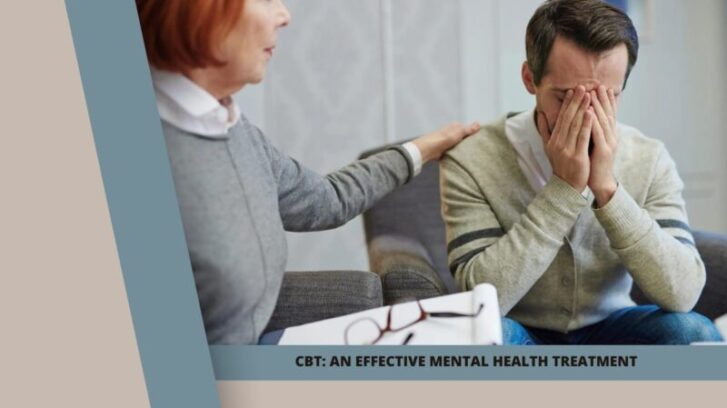Cognitive Behavioral Therapy, or CBT as it’s commonly known, is a real game-changer in the realm of mental health care. This type of psychotherapy has been thoroughly studied and has shown its effectiveness in managing a broad spectrum of psychological disorders.
The core belief of CBT is that our thoughts, emotions, and actions are all intertwined. By transforming negative thought cycles and actions, we can enhance our mental well-being.
The significance of CBT in mental health care is immense. Therapists across the globe utilize it to assist individuals in dealing with mental health challenges like depression, anxiety, post-traumatic stress disorder (PTSD), and many more. The beauty of CBT is that it can be customized to cater to the unique needs of each individual, making it an invaluable resource in the field of mental health.
In this piece, we’re going to take a deep dive into the world of CBT. We’ll explore its guiding principles, its methodology, and its effectiveness in managing various mental health conditions.
We’ll also examine the different variations, such as group therapy and online CBT, and ponder the future of this crucial mental health intervention. Whether you’re a mental health practitioner, a patient, or just someone with a keen interest in psychology, this piece will offer you a wealth of insights into the realm of this.
CBT is a form of psychotherapy that focuses on the relationship between thoughts, feelings, and behaviors. It is based on the principle that our thoughts influence our feelings and behaviors, and that by changing our negative thought patterns, we can improve our mental health.
CBT is a problem-focused and action-oriented therapy, meaning it is designed to address specific problems and encourage individuals to take action to improve their mental health.
The Process of CBT
A typical CBT session involves working with a therapist to identify negative thought patterns and behaviors, and develop strategies to change these. The therapist and the patient work together as a team, with the therapist providing guidance and support, and the patient actively participating in the therapy process.
The role of the therapist in CBT is to help the patient understand their thoughts and behaviors, and to provide them with the tools they need to change these. The therapist does this by teaching the patient cognitive and behavioral strategies, and by providing a supportive and non-judgmental environment where the patient can explore their thoughts and feelings.
The role of the patient is to actively engage in the therapy process. This involves participating in sessions, doing homework assignments, and practicing the strategies learned in therapy. The patient’s active participation is crucial to the success, as it is the patient who ultimately makes the changes to their thoughts and behaviors.
CBT and Depression
This is a highly effective treatment for depression. It helps individuals with depression to identify negative thought patterns that contribute to their depressive symptoms, and to develop more positive and realistic ways of thinking. CBT also teaches individuals with depression behavioral strategies to increase their engagement in enjoyable activities and improve their mood.
There are numerous success stories and research findings that attest to the effectiveness of CBT in treating depression. For instance, a study published in the “Archives of General Psychiatry” found that CBT was as effective as antidepressant medication in treating severe depression and was more effective in preventing relapse. These findings highlight the significant role in the treatment of depression.
Moreover, not only helps to alleviate depressive symptoms but also equips individuals with the skills to manage their symptoms and prevent future episodes of depression. This makes a valuable tool in the long-term management of depression.
Anxiety Disorders
CBT plays a crucial role in managing and treating various anxiety disorders, including generalized anxiety disorder, panic disorder, social anxiety disorder, and phobias. It helps individuals understand the thought patterns that fuel their anxiety, and provides them with strategies to manage their anxiety symptoms.
Real-life examples and research evidence abound regarding the effectiveness of CBT for anxiety disorders. For instance, a meta-analysis published in the “Journal of Consulting and Clinical Psychology” found that was highly effective in treating a variety of anxiety disorders, with effects lasting beyond the end of treatment.
Furthermore, CBT for anxiety disorders often involves exposure therapy, a technique that involves gradually and repeatedly exposing individuals to the situations or objects they fear. This exposure helps individuals reduce their fear and anxiety over time, and gain confidence in their ability to cope with anxiety-provoking situations.
Post-Traumatic Stress Disorder (PTSD)
Key component in the treatment of Post-Traumatic Stress Disorder (PTSD). It helps individuals process traumatic events in a safe and supportive environment, and reduce symptoms such as intrusive memories, avoidance behaviors, and hyperarousal.
Case studies and research results demonstrate the effectiveness of CBT in treating PTSD. For example, a study published in the “Journal of Traumatic Stress” found that this significantly reduced PTSD symptoms in survivors of traumatic events, with improvements maintained at a one-year follow-up.
Moreover, for PTSD often involves techniques such as cognitive restructuring, which helps individuals challenge and change unhelpful beliefs related to the trauma, and exposure therapy, which helps individuals confront and reduce their fear of trauma-related memories and situations.
Eating Disorders
Leading evidence-based treatment for eating disorders like anorexia nervosa and bulimia nervosa. It helps individuals understand the thoughts and behaviors that maintain their eating disorder, and develop healthier eating habits and coping strategies.
Research findings attest to the success rates of CBT in treating eating disorders. For instance, a study published in the “American Journal of Psychiatry” found that CBT was significantly more effective than other treatments in reducing binge eating and purging in individuals with bulimia nervosa.
Moreover, for eating disorders often involves components such as self-monitoring of eating behaviors, challenging dysfunctional beliefs about weight and shape, and developing problem-solving and relapse prevention skills. These components help individuals recover from their eating disorder and maintain their recovery in the long term.
CBT and Obsessive-Compulsive Disorder (OCD)
Highly effective treatment for Obsessive-Compulsive Disorder (OCD). It helps individuals understand the thoughts and behaviors that fuel their OCD symptoms, and provides them with strategies to manage these symptoms.
Research evidence and patient testimonials highlight the effectiveness of CBT in managing OCD symptoms. For example, a meta-analysis published in the “British Journal of Psychiatry” found that CBT significantly reduced OCD symptoms, with effects maintained at follow-up.
Moreover, for OCD often involves a technique called Exposure and Response Prevention (ERP). ERP involves gradually and repeatedly exposing individuals to the thoughts, images, and situations that make them anxious, and preventing the accompanying compulsion. Over time, this exposure helps individuals reduce their anxiety and resist their compulsions, leading to significant improvements in their OCD symptoms.
Children and Adolescents
Not only effective for adults but also for children and adolescents dealing with mental health issues. It helps younger patients understand their thoughts and feelings, and provides them with strategies to manage their symptoms and cope with life’s challenges.
Research findings and case studies attest to the effectiveness of CBT in treating mental health issues in younger patients. For instance, a study published in the “Journal of Clinical Child & Adolescent Psychology” found that this significantly reduced anxiety symptoms in children and adolescents, with effects maintained at a one-year follow-up.
Moreover, CBT for children and adolescents often involves components such as psychoeducation, cognitive restructuring, exposure tasks, and problem-solving skills training. These components are tailored to the developmental level of the child or adolescent, making CBT a flexible and effective treatment for this age group.
Group Settings
Also can be delivered in group settings, providing individuals with the opportunity to learn from others’ experiences and receive social support. Group CBT can be particularly beneficial for individuals dealing with similar issues, such as social anxiety or depression.
The benefits of group CBT include reduced treatment costs, increased motivation through group support, and the opportunity to learn and practice CBT skills in a safe and supportive environment. However, group CBT also has its challenges, such as managing group dynamics and ensuring that each group member’s needs are met.
Research findings support the effectiveness of group CBT. For example, a study published in the “Journal of Consulting and Clinical Psychology” found that group CBT was as effective as individual in reducing symptoms of depression and anxiety.
Online CBT
With the rise of digital technology, online CBT (iCBT) has emerged as a viable and effective form of mental health treatment. iCBT provides individuals with the flexibility to access therapy at their own pace and in their own environment, making it a convenient option for those who may not be able to access traditional face-to-face therapy.
Research results support the effectiveness of iCBT. For instance, a meta-analysis published in the “Journal of Medical Internet Research” found that iCBT was effective in reducing symptoms of depression and anxiety, with effects comparable to those of face-to-face.
Limitations and Criticisms
While CBT is a highly effective mental health treatment, it is not without its limitations and criticisms. Some individuals may find the focus on changing thoughts and behaviors challenging or uncomfortable. Others may prefer a therapy approach that delves deeper into past experiences and emotions.
However, these issues are often addressed in the therapy process. Therapists can adapt the therapy to suit the individual’s needs and preferences, and can provide support and guidance to help the individual overcome any challenges they may face.
Moreover, research continues to support the effectiveness in treating a wide range of mental health disorders, reinforcing its status as a leading mental health treatment.
Epilogue
In conclusion, CBT is a highly effective mental health treatment that has been extensively researched and proven to be successful in treating a variety of psychological disorders. Its focus on changing negative thought patterns and behaviors makes it a versatile and practical therapy that can be tailored to the individual’s needs.
The importance of CBT in mental health treatment cannot be overstated. From treating common issues like depression and anxiety to more complex disorders like PTSD and OCD, has proven to be a valuable tool in the mental health field.
As we look to the future, the prospects of CBT are promising. With the integration of technology and ongoing research, this is set to continue its role as a leading mental health treatment, providing individuals worldwide with the tools to improve their mental health and live fulfilling lives.















